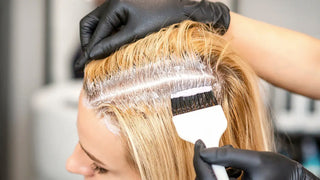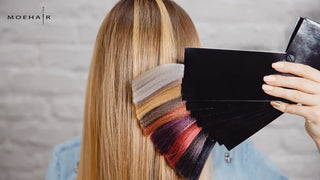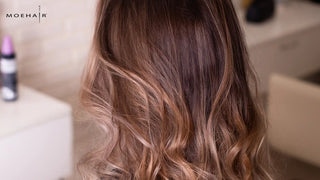 Table of contents
Table of contents
Permanent hair dye alters the natural hair color, offering long-lasting results. But it’s incomplete without a hair color developer. The developer is a proven bleaching agent. It contains hydrogen peroxide at its base, a chemical that causes an oxidative reaction in the cortex. It helps lighten natural pigments and opens the cuticle for absorption of new color molecules. Using it with hair color may also prevent dye allergies. The color developers are classified based on their hydrogen peroxide volume. The higher the volume, the stronger the lightening action.
Spoiler Alert – 20 volume developer is commonly used in salons for consistent gray coverage. It has 6% hydrogen peroxide and lifts up to two levels.
Also Read - Guide To Hair Color Developers
Role of hair color developer
Think of it as a catalyst that accelerates the coloring process. It works by initiating a chemical reaction for color deposition. According to Kristy Slawski, Color Educator, “The developer opens up the hair cuticle so the color can sink in.” When you mix coloring creme with a developer, the dye molecules get activated, giving a salon-worthy finish at home. Without it, the color may only sit on the strands and wash out after a couple of washes. Let’s summarize why a developer is prominently used.

- Color activation – A developer activates the color pigments by releasing oxygen, preparing them for the deposition process.
- Increased color absorption – It guarantees increased color absorption by lifting the natural hair color and removing the existing pigments.
- Uniform shade – Most developers boast a creamy or liquid texture that mixes well with permanent dye and bleach. This ensures even distribution of the product for a uniform shade.
- Long-lasting result – It provides rich, long-lasting color transformations by altering the natural color pigments and depositing new tinge.
- Desired lift – A color developer helps get the desired lift and color by penetrating the hair shaft and locking dye particles in the cuticle.
Different volumes of hair color developer
The color developer plays a vital role in achieving your dream hues. Let’s explore its types and help you choose the right volume.

5 volume developer (1.5%) -
The 5 volume developer exhibits no-lift action and is often used in tandem with semi- and demi-permanent hair colors. It deposits the color molecules on the strands without cuticle penetration. Due to the low volume of hydrogen peroxide (1.5%), it will not lighten your base hair color, thus having minimal effect on the cuticle. It is a lesser-used product that gives a fine tint on gray hair but does not fully cover it. Mix a 5-volume developer with glazes or toners to achieve a glossy finish. For fragile baby hair, consider using it with bleaching powder.
10 volume developer (3%) -
The volume 10 developer is a deposit-only developer. Depending on the product, it may lift the natural color by one level. It contains 3% hydrogen peroxide and helps go one or two shades darker than the existing hue. It sufficiently covers gray hair and provides mild cuticle penetration when teamed with permanent hair dyes. Moreover, based on the application process, a 10 volume developer can be used with bleach for up to two levels of lift. It is perfect for hair darkening and gives a sheer tint to your strands with gray blending.
20 volume developer (6%) -
The 20 developer contains 6% hydrogen peroxide, ideal for complete gray coverage. It is the standard developer used in salons, giving two levels of lift with permanent dyes. This developer offers a long-lasting hue and works well on medium to thick tresses. It activates the dye owing to the opening of the cuticle for color deposition. If you’d like to transform your black hair color to medium brown, use 20 volume developer with bleach, as it lifts up to three levels. Note that it is the highest volume of developer that can be used on the scalp with bleach.
30 volume developer (9%) -
The volume 30 developer contains a higher concentration of hydrogen peroxide (9%), providing three levels of lift. It is best suited for open-air processing. This developer is particularly suitable for covering gray hair, especially for resistant hair types. It is commonly used with lightening creams and permanent hair colors to achieve desired hair color results. It deposits maximum pigments and helps pull off vibrant hues. However, when used with bleach or foil, there is a potential risk of over-processing, which can lead to hair damage and breakage. A strand test should be taken before using a 30 volume developer.
40 volume developer (12%) -
The volume 40 developer is designed to lighten hair rapidly. When paired with permanent hair colors, it offers three to four levels of lift. It is most commonly used with high-lift products. The 40 volume developer is particularly effective at eliminating dark color pigments. It comprises 12% hydrogen peroxide and is ideal for creating highlights or achieving light shades like blonde. Due to its potent lifting capabilities, it is applied only to the lengths of the hair. Also, it is usually not recommended for at-home application unless supervised by a salon professional.
Expert tips and tricks
Understanding different developer volumes is crucial to achieve the desired results. Now that you’ve chosen a color developer, let’s make the most out of it with the following tips.
- It is best to read and follow the labeled instructions carefully. Different brands may recommend different mixing methods and ratios.
- A strand test helps determine the right volume of developer and the required processing time. It makes the coloring process effortless and reduces the chance of uncertainties.
- The color-to-developer ratio depends on the desired lift, developer volume, and hair porosity. The general mixing ratio of permanent hair color to 20 volume developer is 1:1.5 or 1:2 for gray coverage.
- Use a scalp-protecting cream or lotion before coloring to prevent allergies and damage. Also, high-volume developers must not be used on the scalp unless supervised by a professional colorist.
Also Read - How To Choose a Hair Color Developer
FAQs
Q1. What happens if you do not use a hair developer?
Since a developer activates color pigments and opens cuticles for adequate color absorption, not using it may lead to uneven, lackluster hues.
Q2. Which developer is best for dark hair?
The 10 volume developer is best for dark darkening. It sufficiently deposits color pigments and offers gray blending.
Q3. How long can you leave volume 20 developer on hair?
The processing time of a 20 volume developer is 20 to 40 minutes, depending on the desired result and hair type.
Q4. How to mix hair color and developer?
If you are using Moehair Hair Coloring Kit, take 1 part of coloring creme and 1.5 parts of developer.
Q5. What are the natural alternatives to hair color developers?
Lemon juice, baking soda, and honey are natural alternatives to hair color developers. However, these compounds may not equally benefit all hair types.
References:
https://www.medicalnewstoday.com/articles/320505#treatmenthttps://www.onesalonlife.com/beware-of-the-box/
How we reviewed this article:
Our experts continually monitor the fashion and beauty space, and we update our articles when new information becomes available.
-
Current Version
-
Jun 13, 2024
Written By -
Upasana Kakati is a lifestyle writer with 7+ years of experience in writing in the beauty and haircare industry.
Edited By -
Saima Ahmed with 8+ yrs of experience, specializes in crafting engaging content focused on Hair care, lifestyle, and beauty.






















